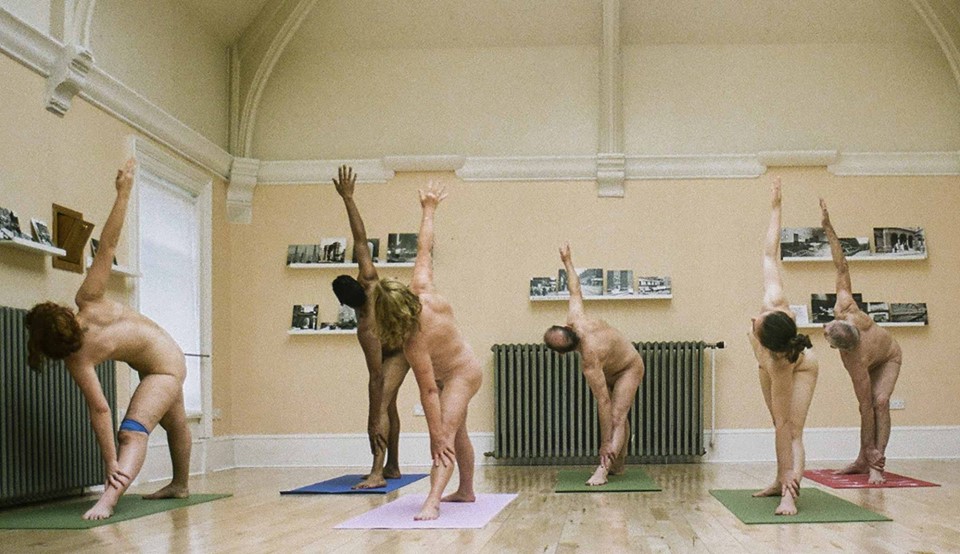In the first article on Grassroots Naturism, I tried to explain how almost anyone – with sufficient time and motivation – could start their very own local naturist group in which to enjoy social nudity. At a minimum, it’s necessary to find 2 or 3 other individuals or families who share your enthusiasm for naturism and social nudity.
However, even if you’re not currently aware of people like that to discuss the idea with, you may still be able to develop an interest in naturism among your nearby friends and relatives. The first step must be to let such people who might be sympathetic to the idea know of your own interest in social nudity. Having identified people like that, then you might be able to “sell” the idea of naturism to them well enough that they’ll be willing to try it out.
If even that seems unrealistic, then you should probably find an existing group to join. That may be done by seeking information from one of the two U. S. national organizations, The Naturist Society (TNS) and the American Association for Nude Recreation (AANR). (Or similar organizations in the country where you live.) Another possibility is to search for naturist groups using Meetup.com. Joining a local or regional group may eliminate any need to start a group of your own. If the only group of this sort you can find isn’t close to where you live, you might join anyhow, in order to ask members of the group to introduce you to social nudists who live closer to you. Yet another possibility is to visit or join a landed club. Even if that is also not close to where you live, by asking around you may get suggestions of people who aren’t quite so far away.
If even that approach isn’t successful, you’ll need to somehow expand your circle of friends to locate the kind of people who could become interested in social nudity. In this post I can’t attempt giving advice on how to do that, but perhaps the subject can be revisited later. How good are you at making new friends?
But let’s assume you can find 2 or 3 people near where you live who already have some potential interest in social nudity, or are at least can be persuaded to try it. What’s the next step? That’s what I’m going to discuss here. Once you have found these people, you should aim to help them become as enthusiastic about social nudity as you are, so that they’ll repeat the same process of finding additional members for the local group you’d like to build. The idea is to start a chain reaction. In the previous article I suggested a number of activities that should provide lots of opportunities for enjoying social nudity, and as a result stimulating enthusiasm for the idea.
Let’s suppose next that you’ve found at least half a dozen people (and/or families) who live close enough together to meet regularly – perhaps at least once a month or so. Then there will be some choices to consider about the future of the group. Here are some of them:
1. Is the purpose of the group just to enjoy social nudity by doing a variety “normal” things, but specifically when clothing is optional. For example, house parties, pot luck dinners, watching TV and movies. Or is it to engage (clothing optionally) in a small set of related activities, such as sports, hiking and camping, boating, beach trips, or whatever. Although having such shared interests can make a group more cohesive, the activities are often the sort done outdoors, and thus seasonal in nature. But some activities that aren’t like that and can be done in any season are things like chess clubs, book clubs, figure drawing and painting, etc.
2. Does a group need to have a formal organization of some sort, with officers, by-laws, newsletters, dues, etc. This is necessary if the goal is to affiliate with a national organization like AANR or TNS. (See next point.) Or do people want to keep things mostly informal, with only enough structure that makes it possible to do sufficient planning and preparation so that get-togethers and special events happen frequently enough to keep people interested.
3. Does the group want to be affiliated with a national or regional organization like AANR or TNS. Then it is necessary to have a sufficient amount of formal structure to meet the requirement of the larger organization. There are some advantages in that the larger organization may be helpful in finding new group members by advertising the group’s existence and allowing for communication with similar groups elsewhere to share ideas. The downside is the need for more formal group structure and (probably) dues. (See the previous point.)
I’m using the term Grassroots Naturism to focus on the kind of social nudity that’s done at the “lowest” level – individual people who share an enthusiasm for naturism, even if they don’t care to use that label for themselves. This is in contrast to the kind of top-down organization that, by definition, is exemplified by national or regional naturist organizations. There’s nothing inherently wrong with the top-down approach – except that it hasn’t been especially successful in recent years. At best, membership in the large organizations has been mostly stagnant for many years, or even declining.
Why is that? Perhaps for several reasons. First, large organizations take on a life of their own. Their top priority is to continue to exist, whether or not they are able to be of service to their individual members. Often the organization’s first priority is the success of landed clubs. There’s nothing inherently wrong with that, except that the individual member is (at best) just a second priority. And the consequence is that individuals aren’t strongly motivated to put effort into spreading the word about the pleasures of social nudity and recruiting new enthusiasts to the fold.
With the “grassroots” (or should it be called “bottom-up”?) approach, on the other hand, the necessary effort is supplied by individuals themselves who enjoy social nudity enough that they’re willing to put their time and energy into “selling” the ideals of naturism to their friends and relatives.
Note that there’s one particular benefit of this type of organization. Since members will generally come mostly from personal friends or relatives of existing members, no extra vetting methods need to be used to ensure that new members understand and subscribe to traditional naturist values (i. e. no mixing sexual activity with social nudity). Of course, that assumes the group doesn’t use some type of public (including online) advertising to recruit new members. Prospective members should at least meet in person with an existing member to discuss their interest in joining, and existing members should be willing to arrange such meetings. Another benefit is that when a new person joins the group, an existing member will be able to introduce the newbie to others. Alternatively, if this process is skipped, some other sort of vetting should be used, such as, for instance, membership in a national or regional naturist group.
I intend to write more on this subject. One possible topic might be ways to use online social media (Facebook, etc.) to help grassroots organizing. Another topic is to identify specific techniques and tactics that could be used to carry on grassroots naturist organizing. For instance, are there low key ways to advertise in local areas, without attracting people who don’t have good naturist values? Should groups participate in “craft fairs”, county fairs, farmers’ markets, etc. in order to advertise their existence? Are their opportunities to participate as a group (while clothed) in civic activities, such as beach clean-ups, trail maintenance, food drives, etc.?
I’d also like to receive feedback on these ideas: questions, comments, constructive criticism, suggestions, missing topics to cover, etc. Are efforts like this currently being done anywhere you know of? Let’s have discussions about this – either here, or in forums dedicated to naturist conversations.
Suggested readings:
The term “grassroots naturism” and the idea behind it aren’t original with me. Around 2010 TNS assembled this document:
Grassroots Naturism: A Guide for the TNS Volunteer
It’s a good resource – as far as it goes. But the concept of “grassroots naturism” that it deals with is somewhat narrower than what’s discussed here. Nevertheless, it’s certainly worth looking at, and there are some useful appendices at the end, such as information on TNS itself and (especially) a nice collection of naturist quotations.
Here are several ways that the scope of this document is too limited:
- To some extent, there’s an assumption that the principal purpose of many naturist groups is to protect the clothing optional status of an established nude beach. While that’s certainly important, it’s hardly the only purpose of a grassroots group. This happens to be the reason that TNS itself originated in the 1970s, and groups that are closely associated with a particular beach are important to help ensure that visitors to the beach do not engage in behavior that’s inconsistent with naturist values.
- TNS desires to see local groups established, because the organization itself has no significant local presence anywhere (except for the headquarters in Wisconsin). It’s strictly a national organization and it doesn’t (at this time) have much ability to help start new groups or support them. It appears, instead, that TNS views local groups (in part) as a way to promote TNS memberships.
- In order to meet the requirements that TNS has for local groups to become part of the TNS “Naturist Network”, the group must be formally organized with officers, by-laws, newsletters, dues, etc. While there are certain obvious advantages to that, if a group is large enough, it’s also possible for a reasonable “grassroots” group to be considerably less formally organized. In fact, that’s the easiest way for a group to get started.
TNS also assembled a more detailed document on starting an operating a local naturist group, perhaps about the same time as the above document. It assumes, of course, that the group will be one with a fair amount of structure, so that it can be part of the “Naturist Network”. Strangely, too, the document is not currently (as of this writing) available at the TNS website. Fortunately, however, it’s available from the B.E.A.C.H.E.S Foundation, an adjunct of the Sourh Florida Free Beaches organization, which is associated with Miami’s Haulover Beach. Here it is:
Some Advice on Starting a Naturist Group
[One has to wonder about the strength of the TNS commitment to actually fostering local naturist groups, given the absence of this material on their website. Although, to be fair, the website has recently had a much-needed rework.]
This document has a fairly detailed list of tasks that need to be done to establish an organized local naturist group. Anyone who already has a list of perhaps a dozen or so people with some naturist experience will be able to follow the advice – because there are enough people among which to divide the work.
[I can’t help noting that the very first point in the part of this document on “Obligations of Network Groups” is this: “Substantial effort to encourage the group’s members to also join TNS.” While TNS is a worthy organization that does good things for naturism in general, it’s clear what their priorities are as far as local groups are concerned.]
The whole problem with the advice in the document is this: How does such an initial group come together in the first place? It’s relatively easy if there’s a nearby nude beach where people can meet each other. Alternatively, some people who know each other as members of a landed club can get together to start their own group that can engage in naturist activities away from the landed club itself.
But what about people who’re learned about naturism online or who’ve been enjoying nudity at home and want to find others like themselves? How does a group of people like that come together in the first place? That is exactly the issue that this series of articles here is meant to address.
Part III of this series will look at the general topic of “organizing” a group of people for some social purpose, of which naturism is just a special case.



